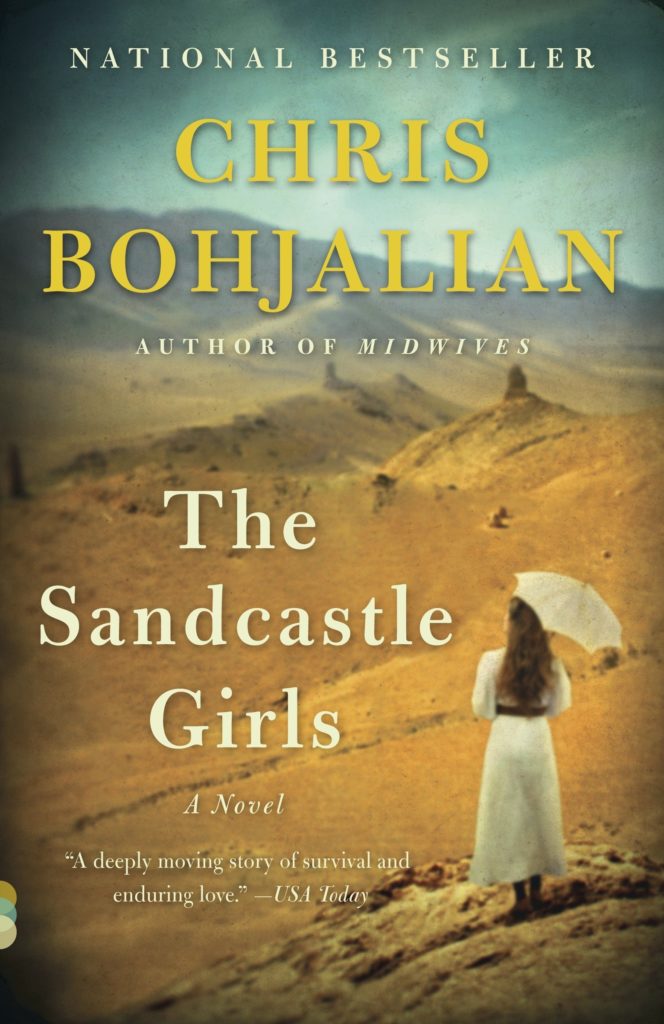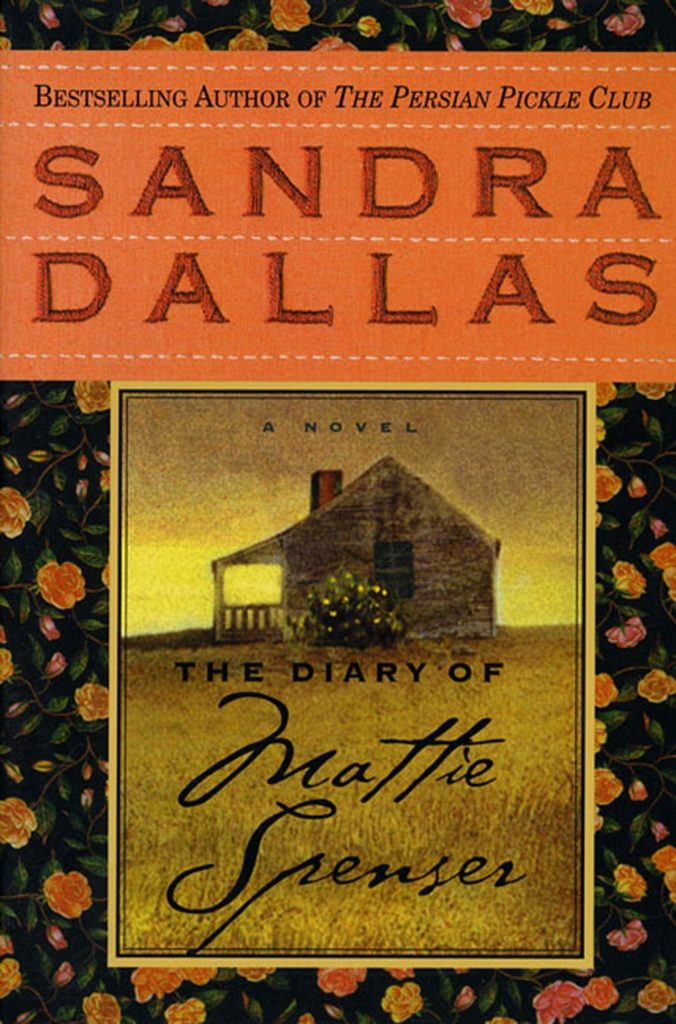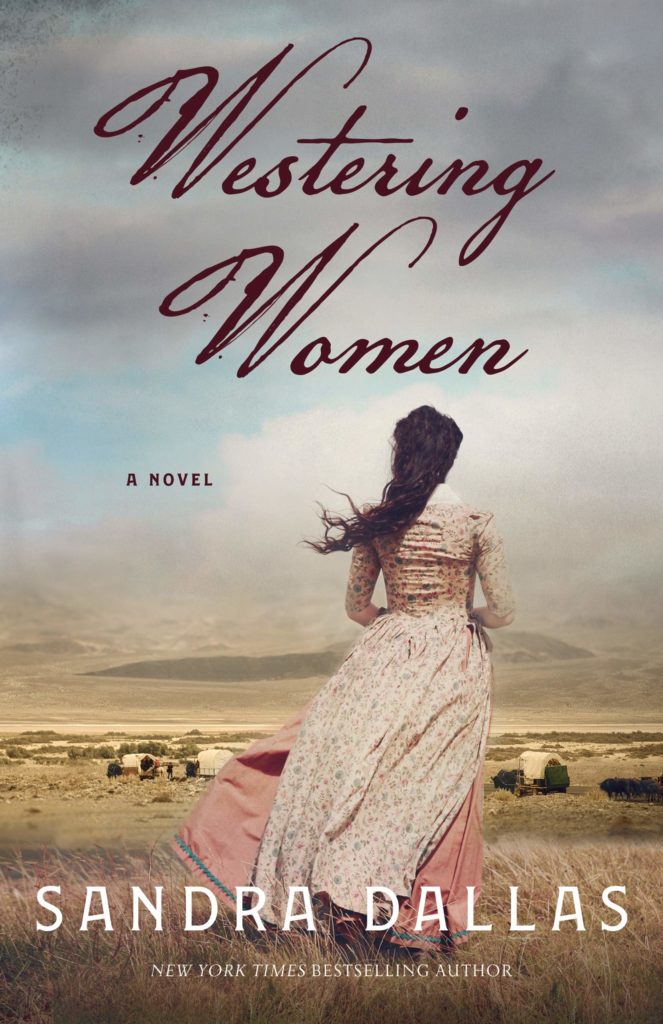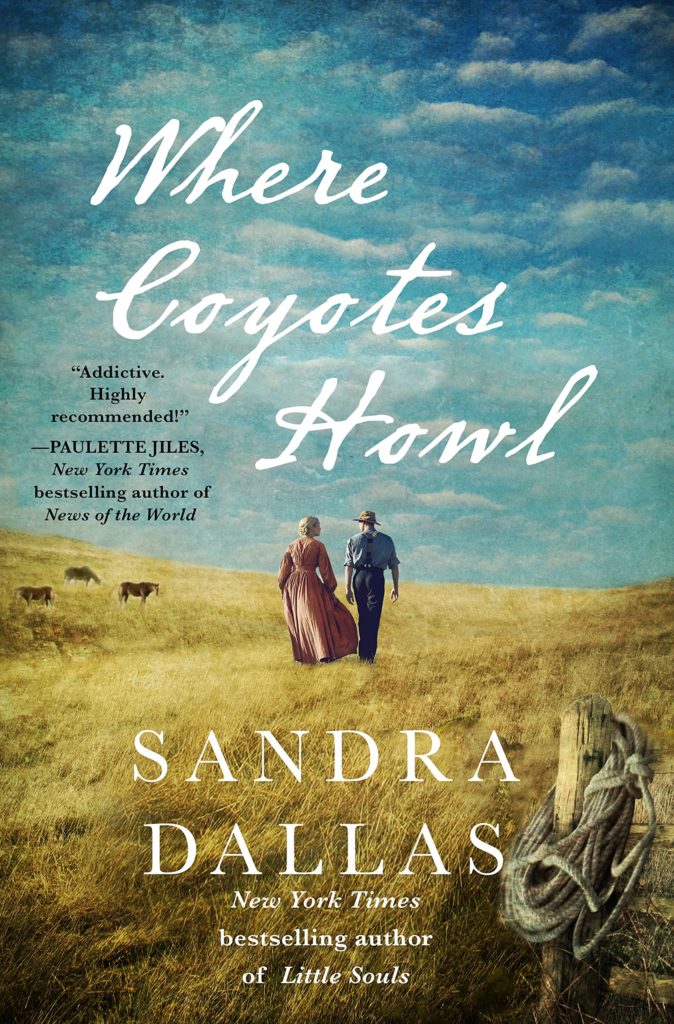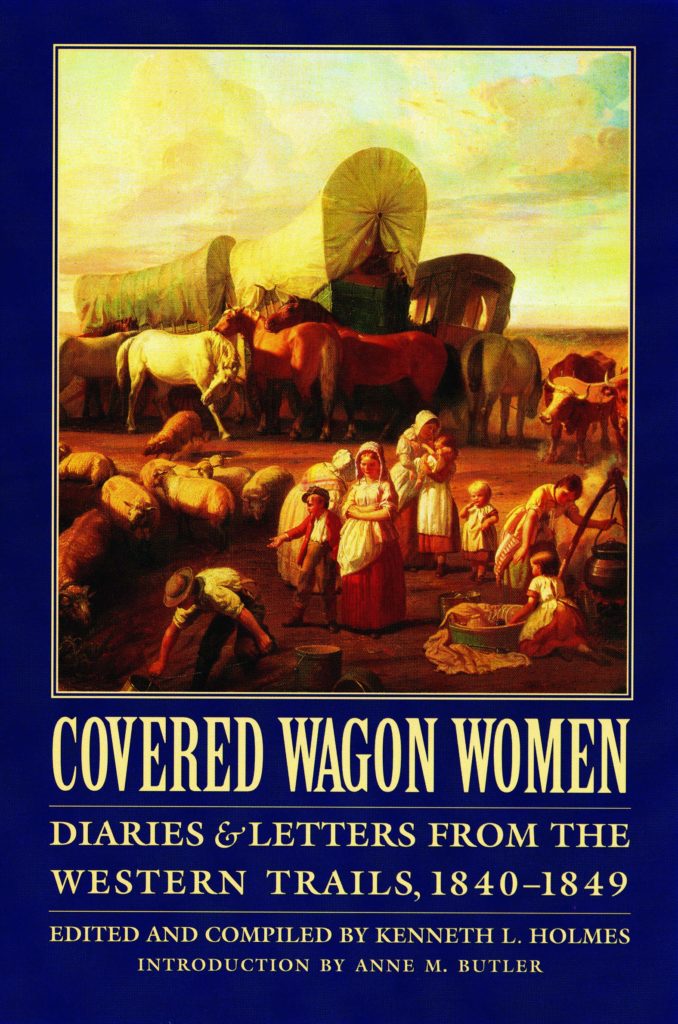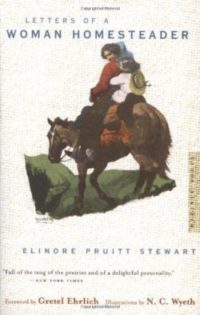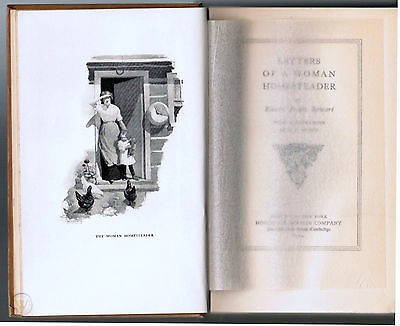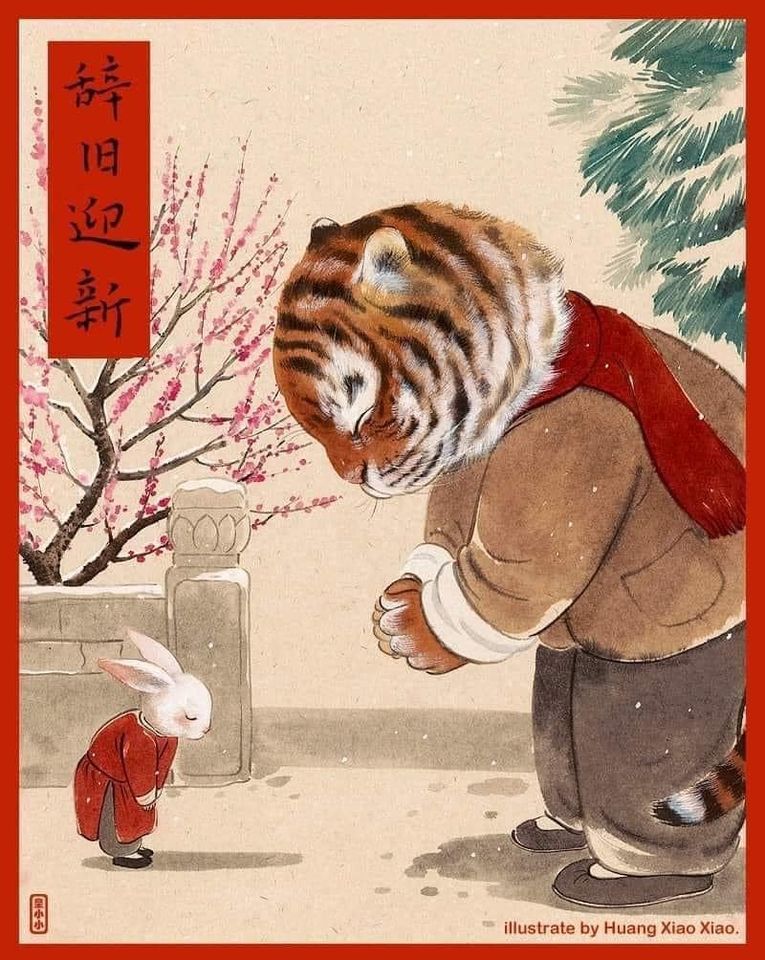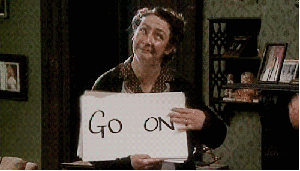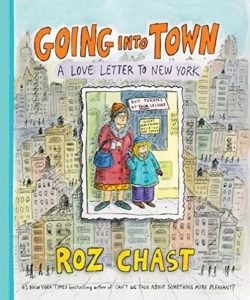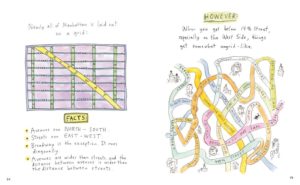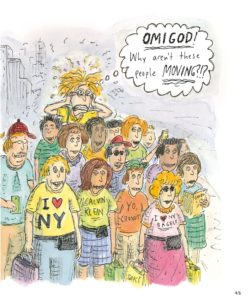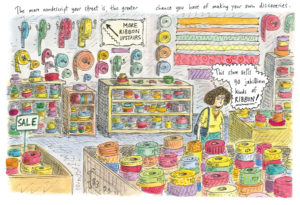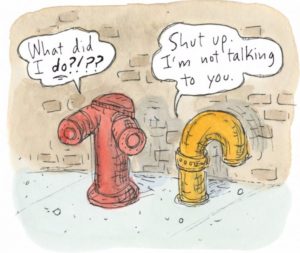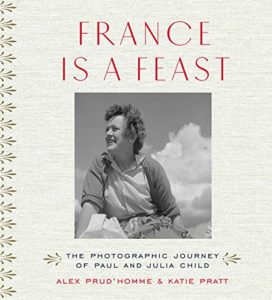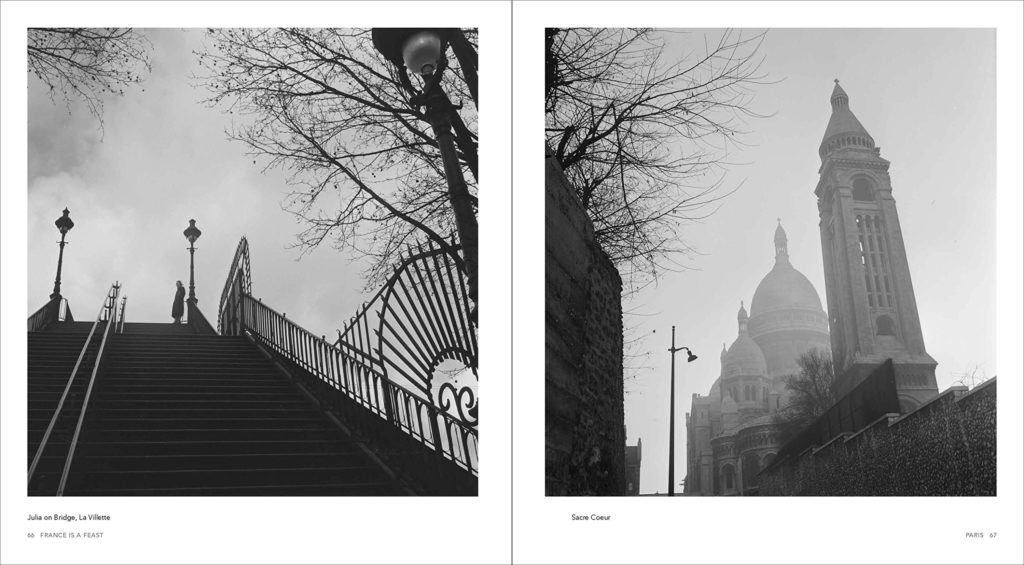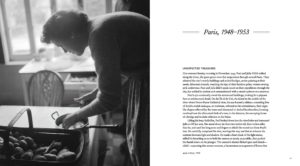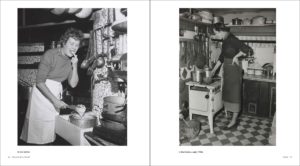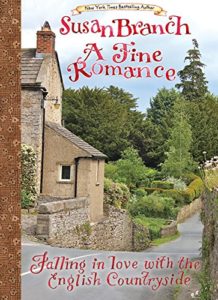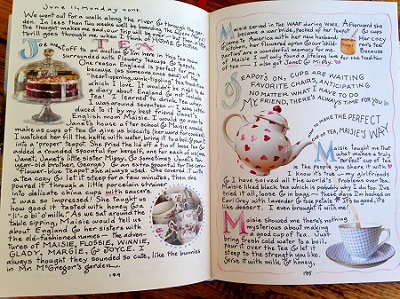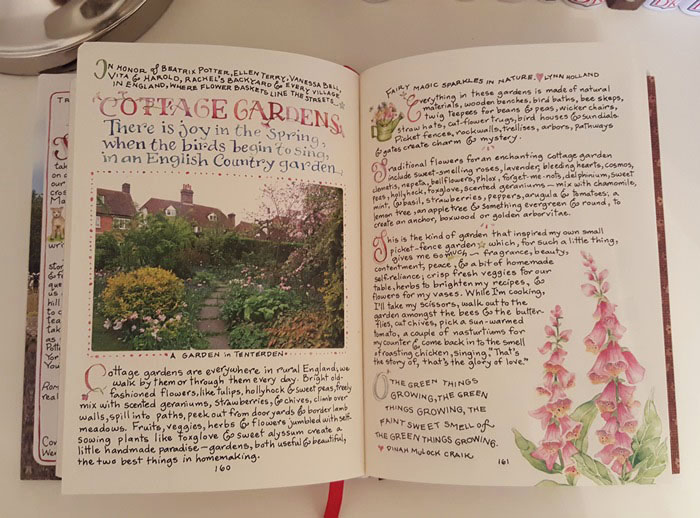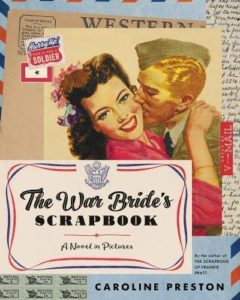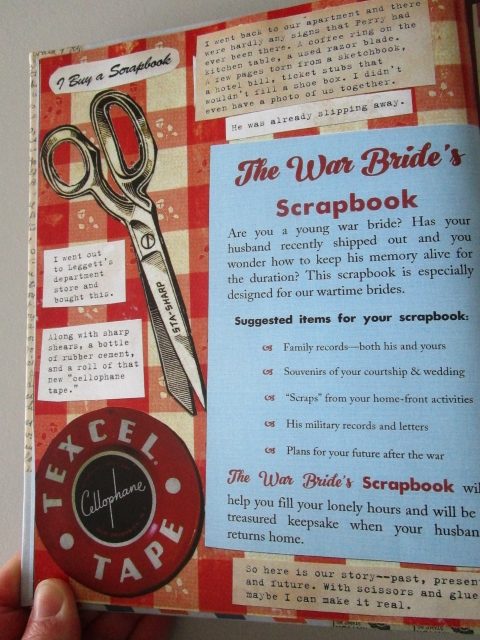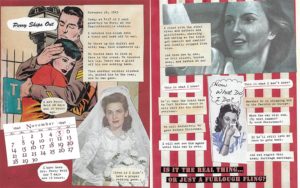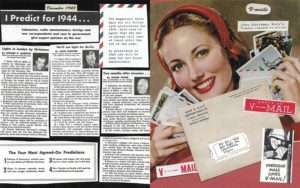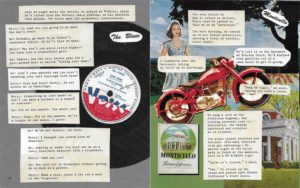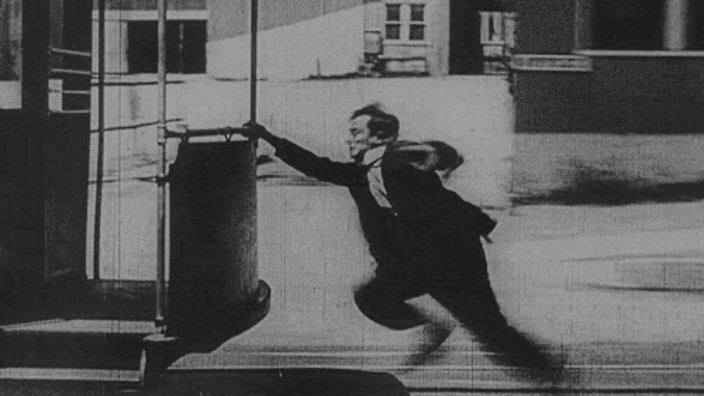The Sandcastle Girls by Chris Bohjalian
Here at Book Barmy headquarters, we are thrilled when a friend gives us a book they enjoyed, especially when it comes with their review and backstory.
Such was the case with The Sandcastle Girls. My friend included a note with the book which told of her friendship with with a daughter of Armenian immigrants and how this story is about a little-known chapter of Middle-Eastern history.
Mr. Bohjalian has taken this little known, but horrific piece of history — the killing of thousands of Armenians by Turks in 1915, and used it as the backdrop for a love story of two very different people who meet in Aleppo (modern-day Syria) — the Ottoman Empire during World War I.
Aleppo served as a way-station for refugees who had already been marched through the desert with no food or water. Americans, Brits and others, including some Muslims, ministered to them and tried to save lives during the refugees’ brief respite before they were marched out into the desert yet again – to a camp which almost guaranteed their eventual deaths. In Aleppo, Elizabeth Endicott, is a young, wealthy woman from Boston who, with her father, is administering aid to the refugees. She falls in love with Armen Petrosian, an Armenian engineer searching for his wife and infant daughter who have been rounded up by the Turks.
The Sandcastle Girls interweaves of the story of Elizabeth and her father Silas, along with others in Syria to aid the refugees along with the secondary story of their granddaughter Laura who is researching information about her grandparents.
In the early pages of this novel, Laura sets the stage for this undiscovered story of her grand-parents:
Nineteen-fifteen is the year of the Slaughter You Know Next to Nothing About. If you are not Armenian, you probably know little about the deportations and the massacres: the death of a million and a half civilians. Meds Yeghern. The great crime. It’s not taught in school, and it’s not the sort of thing most of us read before going to bed. And yet to understand my grandparents, some basics would help. (Imagine and oversized paperback book with a black-and-yellow cover. The Armenian Genocide for Dummies.)
Through vivid detail the author takes us to the dry, harsh deserts of death, and into the protected circle of the American compound in Aleppo. From there we are brought back to America, and the pieces of the family puzzle come together through long forgotten details, sadness, love and finally understanding.
Mr. Bohjalian gives us a well-paced story line with his characters’ stories and their relationships. However, I found that the sections detailing the actual history of war, were interesting, but slow reading — I had to force myself to carry on and often put it away to read something else.
That is not the only reason why it has taken me so long to finish this book, this is a difficult and oftentimes disturbing book about the atrocities and horrors of this great crime — a genocide that is still impossible to discuss in today’s Turkey, where denial is the rule.
In a burst of resolution the other evening, I finally finished it and have to say The Sandcastle Girls is well worth reading even with the troubling content. Such historical fiction like Mr. Bohjalian’s is important – because it reaches readers like myself who learn of the past through stories told.
N.B. I wish I were a reader of history tomes, I want to be, but the David McCulloughs sit on my shelf, unread to this day. Maybe, like poetry, I will venture in…
Sandra Dallas
You may remember my post about kicking my attitude out of funk with some reading of the trials and struggles of the women who settled the West. That got me thinking about the author Sandra Dallas. If you don’t know about Ms. Dallas and you like historical novels — you should try and find any of her books.
My favorite of hers is one that holds a place of honor on my shelves and I recently re-read it for, I think, the third time.
The Diary of Mattie Spenser by Sandra Dallas
Newly weds Mattie and Luke are traveling in a covered wagon to build a home in the Colorado Territory. They settle in this new frontier, which is so isolated and bleak that it drove many women, and a few men, to madness.
We read of their hardships — Indian attacks, isolation, no plumbing or electricity not to mention, no doctors or medicine. Mattie finds solace in her private journal, where she records the joys and frustrations not just of frontier life, but also of a new marriage to a handsome but distant stranger. This novel is told in the form of her diary entries – a writing style I have a particular fondness for — as with epistolary novels.
Mattie is a woman of extraordinary virtues — she is decent, educated, kind and capable, and she accepts her bridegroom’s choices and the old-fashioned concept of helpmate.
Ms. Dallas is the former Denver bureau chief for Business Week magazine and lives in Denver, Colorado. She is known for her extensive research, so her readers can truly inhabit and understand the time and the place in which she sets her stories. Like all of Ms. Dallas’ novels, this story pivots on a terrible secret. I must admit that each time I read The Diary of Mattie Spenser, I am still surprised and a little troubled with this secret and how the diary ends. Without giving anything away, I will tell you Mattie’s tough decision highlights how far women have — okay, may have — come in terms of both rights and freedoms within society.
And once again, I felt lucky as I read this saga safe in my warm home, under the light of a good lamp.
The Diary of Mattie Spenser is a wonderful book that I have re-read yet again and will likely read again — and if you’re like me it will stay with you for years.
~~~~~~~~~~~~~~~~~~~~~~~~~~~~~~~~~~~~~~~~~~~~~~~~
Westering Women by Sandra Dallas
Now because I hadn’t had enough reading about strong women settling the West, I dived into another Sandra Dallas last week and finished it this morning over a cup of tea.
It’s February, 1852, and all around Chicago, Maggie sees postings soliciting “eligible women” to travel to the gold mines of California. A young seamstress with a small daughter, she has nothing to lose. Thus begins the tale of wagon train of women headed to a new life. They were to find husbands among the miners who had been lured to California by the prospect of gold. Led by two ministers, this wagon train of women would make an arduous two thousand mile trek. Sometimes riding but more often walking (sometime barefoot) each woman is escaping a past, finding themselves, their strength, their fortitude in an unforgiving culture of 19th century patriarchy. It was a journey that not all would complete, but it would make the women eventually band together as sisters.
Westering Women is aimed towards a young adult audience. And I don’t know if this was why it was not my favorite of Ms. Dallas books. Still, I found it riveting enough to finish and it was a quick read. A plus when reading young adult books.
A digital review copy was kindly provided by St. Martin’s Press via NetGalley
~~~~~~~~~~~~~~~~~~~~~~~~~~~~~~~~~~~~~~~~~~~~~~~~~~
Ms. Dallas has also written novels set in the 1930’s Mississippi, the Kansas dust bowl, as well as a few set during the Civil War. I’m not usually a fan of what is termed ‘women’s fiction’ and yes, women are always the central force in her novels — but these are different, she writes of women’s struggles, their deep reservoirs of strength, and the all-important friendships with other strong women of the time.
Here’s some of the titles I’ve read over the years.
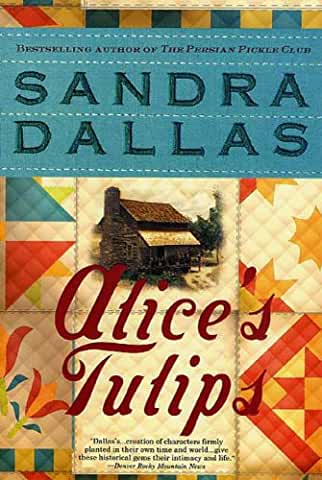
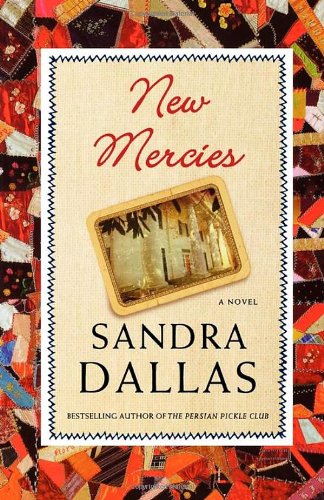
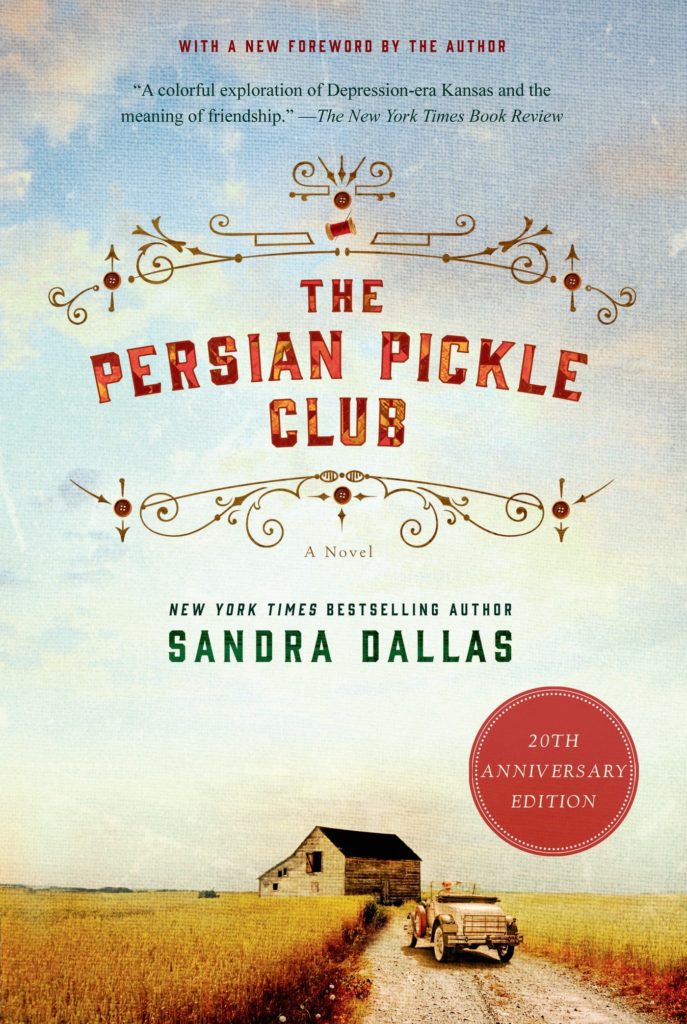
~~~~~~~~~~~~~~~~~~~~~~~~~~~~~~~~~~~~~~~~~~~~~~~~
But wait there’s more
Thanks again to St. Martin’s press, I also have a proof copy of Ms. Dallas’s newest book, Where Coyotes Howl, which will be published in April. I’ve read the publicity blurb and it sounds great.
Can I take another harrowing, yet uplifting story of women settling the West?
Why, yes, I think I can – there is just something about this author and her writing – I can’t stop…
In case you want to pre-order it – here’s the cover. I’ll review it properly closer to publication.
A Kick in Attitude
This past weekend, I pulled my back wrong and then my knee started acting up and I was hobbling around like I was ancient (which I’m not – yet). Then, given the horrific shootings, Chinese New Year was a somber affair among our neighbor friends. No parties or sharing of cheerful foodstuffs.
In short, I was feeling sorry for myself, a state of mind which I abhor.
Whenever I catch myself having a pity party — I pull out either of these two books and open to any page to remind myself what a plum and cushy life I lead.
Covered Wagon Women
Edited and Compiled by Kenneth L. Holmes
Covered Wagon Women was recommended by friend (looking at you, with love, GH) many years ago and it still has a treasured place on my shelves — just for times like this when I need to kick my ass attitude out of an inappropriate bad mood.
These are the collected diaries and letters of fourteen pioneer women traveling west in covered wagons during the 1840’s.
Mr. Holmes, a historian has left everything in its original source — unedited diary entries, letters and other correspondence. This is how the women actually wrote then, complete with original dialect, spelling, and punctuation — complete with mistakes. The women speak in their own voices, without any modern influence. It will take you a few pages (or chapters) to get into the rhythm of their voices — and figure out the spelling — but after a bit, you get the hang of it. Whenever I re-open this book and read an entry or two, I always feel like I am actually there in the wagon listening to their personal accounts.
Every entry gives a slightly different viewpoint on the hardship and horror these remarkable women experienced and endured to discover new lives out west. Some are mundane, others soul-crushing, and some spirit-lifting. We read of Tamsen Donner and young Virginia Reed, members of the ill-fated Donner party; Patty Sessions, the Mormon midwife who delivered five babies on the trail between Omaha and Salt Lake City; Rachel Fisher, who buried both her husband and her little girl before reaching Oregon.
Because this collection is told from a woman’s point of view, domesticity is shown to be a means of survival, much as a gun. They cooked meals every day under dire circumstances. They sewed, weaved, knitted and mended clothes and bedding. They washed up when they had enough water, but went dirty for weeks if required. They walked miles over some of the roughest terrain America possesses – rocks, sand, dust, mud – over flat rutted trails and up and down mountain paths. They fed and milked cows, helped keep oxen and horses alive, birthed babies and buried them.
There is much unsaid in these letters. They rarely speak of their personal suffering, but instead relate what happened simply and factually. Despite the brevity, when a letter mentions how long they went without water and how many animals and people died because of it, it is easy to read between the lines.
There are 11 books in this series, and maybe someday I will tackle more, but for now this first in the series is enough to remind me of the luxuries in my life – water at the turn of a faucet, a warm bed, soap – well, you know what I mean.
Get yourself out of your bad mood and check out Covered Wagon Women – available at your local library.
Letters of a Woman Homesteader
by Elinore Pruitt Stewart
In the same vein, but not nearly as grim, is Letters of a Woman Homesteader, which I have read cover to cover.
As a young widow Elinore Pruitt left Denver in 1909, with her young daughter, and set out for Wyoming, where she hoped to buy a ranch. Determined to prove that a lone woman could survive the hardships of homesteading, she initially worked as a housekeeper for a neighbor — a kind but taciturn Scottish bachelor, whom she eventually married.
In twenty-six letters written to a friend back in Denver, she joyfully records her days, not considering the life she has chosen on the frontier as hardship. Instead, she revels in the natural beauty of her surroundings and in her friendships with like-minded women in her frontier community.
Elinore and her friends, face the unexpected with courage and good humor. They live unselfishly, and are overly generous with kindness and deeds for those less fortunate. She tells of unified and skillful hospitality; impromptu weddings, spur of the moment feasts for strangers, and designing and sewing wardrobes for a needy family in just a few days time.
Spring and summers were hard, she concedes, and were taken up with branding, farming, doctoring cattle, and other chores. But with the arrival of fall, Pruitt found time to take her young daughter on camping trips and serve her neighbors as midwife, doctor, teacher, Santa Claus, and friend.
My well-worn copy contains the original illustrations by N. C. Wyeth. However, I found out the digital version of Letters of A Woman Homesteader is free — as this classic is in the public domain.
Described by the Wall Street Journal as “warmly delightful, vigorously affirmative,” this classic of American frontier life will charm today’s audience as much as it fascinated readers when it was first published in 1914.
The reading is indeed enjoyable and flows beautifully — it reads like a novel.
So there you go. In a bad mood? Need a good kick in the attitude? Instead of self help books or those cheesy gratitude journals, read about women who met extreme hardship and tough lives with bravery, strength, humor, kindness, and grace.
Now I have to go unload my wonderfully modern and convenient dishwasher – no tin pans rinsed in the creek for me.
I’m a very lucky gal – pity party is over.
With respect to the new Lunar New Year.
The Language of Food by Dan Jurafsky
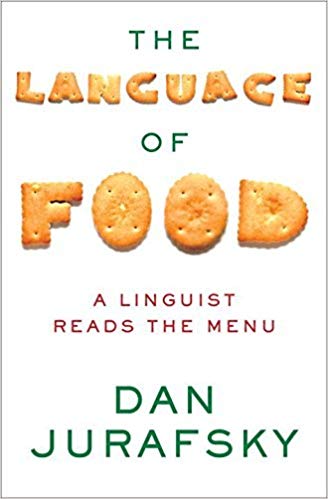 The Language of Food A Linguist Reads the Menu
The Language of Food A Linguist Reads the Menu
by Dan Jurafsky
Fellow foodie friends loaned me this book. We share a love of cookbooks, cooking and seeking out new foods — but they touted it as a completely different type of food book ~~ The Language of Food is just that – like nothing you’ve ever read.
Written by a professor of linguistics and computer science at Stanford University, Mr. Jurafsky (and his team) devoted many (many) hours exploring the origin of food terminology — from food names to the nuances of menu writing — and happily melded it all with computerized linguistic tools to evolve the genesis of this book.
Whoa, I first thought — way above my mental pay grade, but I was instantly fascinated by the introduction, in which the author explains his fascination with food linguists and how it involves the science, history, and culture of many regions. He explains the origin of ‘ketchup’ which derives from a pungent Chinese fermented fish sauce pronounced ke-tchup in Cantonese. This sauce was brought back to Europe by English and Dutch explorers and evolved over 400 years to suit Western tastes and become today’s ubiquitous tomato based condiment. Macaroni descends from a Persian almond pastry which intermingled with the pastas of the Arabs to become pasta. And toasts at weddings historically involved toasted bread.
The first chapter of The Language of Food is devoted to menus and their language. You will both chuckle and be struck at restaurant menu manipulation Back in the 1970’s the use of French denoted expensive and swanky meals – such as ‘Fried Chicken a la Maryland’ or ‘Ravioli en casserole’. Today fancy restaurants do the same thing with often ridiculous descriptions of the origins of the food — grass fed, pasture raised, green market cucumbers (this is especially rampant here on the West Coast and was lampooned in a very funny episode on Portlandia — watch clip HERE.)
But I digress…
Restaurant price points are so ingrained in their menu language that we’re not even aware of it (at least it never occurred to me before). Expensive restaurants use ‘chefs daily selection’ or set prix-fixe menus. In contrast, cheaper places give the diner a lot of choice – not only do they have far more dishes, they also prepare meals to your liking ‘prepared your way’. In fact Mr. Jurafsky points out that the words ‘you’ and ‘your’ appear much more often in cheaper restaurants. And what about middle-priced places? — well they tend to use lots of adjectives such as this mouth watering description of an apple pie:
Rustic Apple Galettte: Hand crafted tart in five inches of butter flaky french puff pastry. We layer fresh ripe apples and bake to a golden brown.
I’ll leave this menu chapter now, but not before I point you to something mentioned which I almost missed – the NY Public Library Menu Collection. I had great fun wasting time one rainy evening. Just take a look and click on some of these wonderful old menus that have been digitally preserved – such as from ocean liners back in the early 1900’s or you can enter a favorite restaurant from your memory and there it is. Such fun.
Okay back to the book.
Sex, Drugs, and Sushi Rolls is an eye-opening chapter on the power of language in restaurant reviews – and how reviewers often use words connected to sex or drugs to hype — such as ‘the chicken wings are addicting’ or ‘the ice cream pastry was just orgasmic’. Perhaps most interesting was the scientist’s investigation into often rigged on-line reviews (such as Yelp) which can sadly bring down a perfectly good restaurant.
In other chapters, you’ll get to read about junk food marketing and how advertising copy got us to crave potato chips and kettle corn at festivals. You’ll learn why the Chinese don’t have dessert and how today’s group cooking/dinner parties evolved from cooking clubs in a mouth watering region in Basque.
I think it comes with the territory, that a food linguist/computer scientist can and will get pedantic. So I must admit I didn’t entirely get through each and every chapter, but I did read quite a bit more of this book than I originally thought I would – (see Mental Pay Grade above…)
The Language of Food is sometimes geeky but more often actually quite fascinating, and I applaud Mr. Jurafsky for devoting so much effort to bring us such delightful insight into the language, history, culture and origins of our food and eating experiences.
I’m off to make our dinner and it’s definitely going to be chefs choice…. 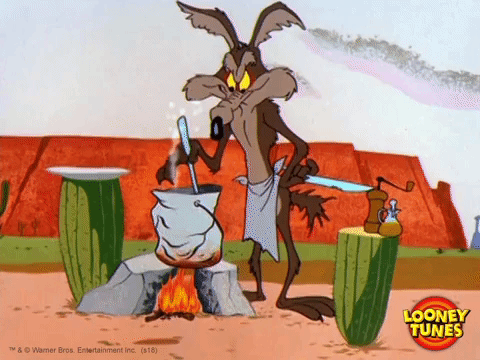
A Picture is Worth a Thousand Words
I’ve been gathering some picture books to tell you about all at once. This winter, I enjoyed these visually enchanting escapes which took me from the streets of New York, to France, and even wartime England.
Well, grab a beverage of choice and sit right down next to me and let’s look at them together.
~~~~~~~~~~~~~~~~~~~~~~~~~~~~~~~~~~~~~~~~~~~~~~~~~~
Going Into Town
A Love Letter to New York
by Roz Chast
When Ms. Chast’s daughter was preparing to move to Manhattan for college, Ms. Chast wrote up a tongue-in-cheek guide book with tips for suburbanites navigating the city. This little booklet turned into Going Into Town: A Love Letter to New York which is a cartoon book about all the things Ms. Chast appreciates — or doesn’t— in the city she loves.
I love Ms. Chast’s work and always chuckle at her cartoons in the New Yorker magazine, on greeting cards, or her books. Remember THIS?
This book is a collection of stories and visuals — the “overheard and the overseen”, on the streets of New York — and Ms. Chast is her usual funny and cynical self.
She starts with a brief background on how she and her family moved out of the city to the suburbs for the better schools and the chance to have actual trees. But the downside was that her daughter had no city skills when venturing to university in the city.
There’s an introduction to the geography of Manhattan
Diners are all but extinct, hawks aren’t, Uber cars outnumber taxis, and in GENERAL:
3 blocks = 1 avenue
20 blocks/7 avenues = 1 mile
even streets run east, odd run west, crosstown run east-west
Going Into Town then goes on to describe the people you’ll encounter, with special warnings about the tourists…
It is evident throughout the book that poor Ms. Chast greatly misses living in the city. There’s a section on the things to do from the obvious Broadway musicals and gallery openings to the more obscure — “best hat on a dog contest”. She advocates looking — really looking — as you walk around — freshly seen through her quirky visual lens.
While Ms. Chast may have wanted to give her daughter a straightforward guide to the city, she can’t help herself and interrupts the narrative with delightful digressions about such things as the quirky stores that sell nothing but ribbon or enticing off-brand lipstick.
or the city’s great variety of standpipes,
As the title says, this is Ms. Chast’s very own love story to New York:
I feel about Manhattan the way I feel about a book, a TV series, a movie, a play, an artist, a song, a food, a whatever that I love. I want to tell you about it so that maybe you will love it, too. I’m not worried about it being ‘ruined’ by too many people ‘discovering’ it. Manhattan’s been ruined since 1626 , when Peter Minuit bought it from Native Americans for $24.00.
And, if like me, you’re stuck on the opposite coast – you’ll have a hankering to follow the author’s advice:
One of the greatest things you can do in life is walk around New York
~~~~~~~~~~~~~~~~~~~~~~~~~~~~~~~~~~~~~~~~~~~~~~~~~~
France is a Feast
A Photographic Journey of Paul and Julia Child
by Alex Prud’ Homme & Katied Pratt
From the coauthor of My Life in France, this volume is a collection of the photographs taken by Paul Child during his and Julia Child’s years in France.
This is a sometimes fascinating look at the lesser-known Paul Child, who in fact, was a talented artist, photographer, painter, lithographer, woodworker, metalsmith, stained glass expert, writer and poet.
Here’s just a sample of his fine photographic eye:
But Paul also delighted in photographing Julia:
She[Julia] was ten years younger than Paul, and not well known at the time, but she was a sunny, questing, powerful personality who had a profound impact on her husband’s evolution. He adored her and photographed her constantly; without realizing it at the time, he was chronicling her rise from a fumbling know-nothing in the kitchen to an accomplished cook and author, and America’s first celebrity TV chef.
Because of my slight obsession with Julia Child, I found myself lingering on those iconic photos:
My Life In France was one of my favorite books about Julia and Paul’s life in France and I had high hopes for this photographic essay. However, their relationship is sketched over and the often pedantic writing is focused on Paul Child, his career and interests. The final pages are devoted to the Child’s move back to Cambridge and Paul’s decline which Julia handled with courage and grace. Don’t get me wrong, I wanted to know more about Paul Child but I often lost interest. Perhaps he will always remain in Julia’s shadow.
The photographs are fascinating and France is a Feast for the eyes, but alas, not the writing.
~~~~~~~~~~~~~~~~~~~~~~~~~~~~~~~~~~~~~~~~~~~~~~~~
Falling in love with the English Countryside
by Susan Branch
A friend gave me an Amazon gift card for Christmas and I quickly ordered A Fine Romance. I had longingly thumbed through this beautiful book in a little bookstore ages ago and added to my list of “someday books”. Well, this past January was that someday.
This is not a travel guide, there is no agenda here other than to entertain and delight the reader A Fine Romance is a hand-written, illustrated chronicle of Ms. Branch’s visit to England with her husband. I lingered over almost every page — each watercolor is a tiny jewel — all interspersed with photographs, her reflections and observations
Here I’ll show you:
I read bits of this book each morning (with the obligatory cup of tea) in order to slowly savor the experience of going along as they roam the English countryside.
The book opens with the story of how the divorced Ms. Branch met Joe, which proved a bit tedious as well as, well, creepy. Here’s the creepy bit; on one of their first dates, she asked for two hotel rooms but behind her back he reserves only one. She’s surprised,unsure but just goes along with it. (Say what? Ever heard of respect for boundaries?)
This little niggle in no way detracts from the charm of the book (I just had to make that comment).
Apparently Ms. Branch has a huge following and has an impressive website with recipes, events and merchandise which sports her watercolors on everything from calendars to party favors. A bit over the top for my taste, but take a look HERE to see what you think. She also has a BLOG which I enjoy, especially the travel entries, just to admire their elegant travel style — always accompanied by a great deal of luggage.
A Fine Romance is not only for Anglophiles, but for anyone who likes pretty villages, cozy cups of tea, and beautiful gardens. Part travelogue, part diary, part sketchbook, part personal scrapbook — A Fine Romance is just wonderful.
~~~~~~~~~~~~~~~~~~~~~~~~~~~~~~~~~~~~~~~~~~~~~~~~~~
The War Brides Scrapbook
by Caroline Preston
I loved Ms. Preston’s previous novel, The Scrapbook of Frankie Pratt ,a gift from my sister. So I had to purchase another “someday” book — her newest scrapbook novel, The War Bride’s Scrapbook.
It is 1941 and Lila has graduated from Sweet Briar without the two things her mother expected; making connections with moneyed friends and a rich fiancee. Instead she came home with a magna cum laude and an art degree. Her true passion is architecture, but there’s little opportunity for women in the field. She goes to work instead for her father’s insurance business. She meets and falls hard for enlisted soldier Perry Weld and, after a three week whirlwind romance and marriage, he has shipped out.
Following the advice in a woman’s magazine,
Lila starts a ‘War Bride’s Scrapbook’ in which she chronicles their two-year separation — through their letters, but also tickets, menus, food labels, and newspaper articles.
This ‘story in pictures’ is told through this scrapbook device, as we get to know the characters and their experiences both at home and in war-time Europe.
Just take a look at this visual and literary feast.
Lila matures into a strong independent woman who eventually gets accepted into the male-dominated Harvard architecture school and onto a career of her own.
Ms. Preston uses this scrapbook to give us a insight into the issues of the time — the changing roles and societal expectations for women, PTSD, the atomic bomb, and even the Japanese American imprisonment.
Many of the visuals are from Ms. Preston’s own collection of vintage scrapbooks and ephemera, but she also did a fair share of research and borrowed items from other artifact collectors.
The War Brides Scrapbook brims with vivid characters and a brilliantly laid-out collection of WWII-era ephemera.
~~~~~~~~~~~~~~~~~~~~~~~~~~~~~~~~~~~~~~~~~~~~~~~~~~~
Whew, congratulations you made it through this long post. So now, we’ll have to return to the real world of grown-up books -most, sadly without pictures.
Catching up to the New Year
Every year I look forward to a quiet week between Christmas and New Years. The holiday feeling is still in the air, the house is cozy and perfect for some major league reading.
Happily, once again, the week was jammed with fun events — entertaining friends, a belated Christmas celebration with others…and even a BBQ with some other friends (sorry to those on the East Coast, but we did eat indoors).
Given all this merriment, I’ve yet to catch up with the New Year and have neglected Book Barmy.
So my New Year starts today. Putting away Christmas things, the last of the treats have been eaten (except for some very yummy peppermint fudge ice cream which only comes out once at year from our favorite ice cream place), and I’m back here to tell you about a book I did get to read last week.
~~~~~~~~~~~~~~~~~~~~~~~~~~~~~~~~~~~~~~
NEW! ~~ Email Notifications
But first a bit of housekeeping: If you did not receive an email notification of today’s post and you wish to do so ~~ just enter your email address below right. You will then receive an email to verify your address and you’re done. It’s a new format so you will have to sign up again. Thanks and Happy New Year to all my loyal subscribers.
~~~~~~~~~~~~~~~~~~~~~~~~~~~~~~~~~~~~~~~~~
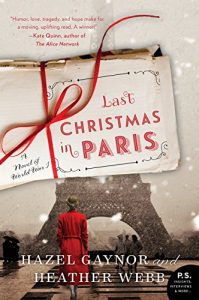
Last Christmas In Paris
by Hazel Gaynor and Heather Webb
In spite of the cheesy cover, this novel grabbed me from the opening pages — and why not? It’s written in my favorite epistolary style, set during WWI, and somewhat about Christmas.
From the blurb:
August 1914. England is at war. As Evie Elliott watches her brother, Will, and his best friend, Thomas Harding, depart for the front, she believes—as everyone does—that it will be over by Christmas, when the trio plan to celebrate the holiday among the romantic cafes of Paris. But as history tells us, it all happened so differently…
Evie, is a British society girl who yearns to do more for the war effort than rolling bandages and knitting socks. Her best friend Alice, her brother, and her brother’s best friend Thomas are all on the front line and having seemingly exciting adventures.
Last Christmas in Paris was co-written by two authors Ms. Gaynor wrote as Evie, and Ms. Webb wrote as Thomas, Evie’s brother’s best friend, a scholar who sees the war as a chance to escape from running the family newspaper. This results in two distinct voices, which through their letters reveal their personalities, hopes, and ultimately their fears during this ‘war to end all wars’.
Initially the letters are full of lighthearted banter as this young group is carried along by the excitement of war, but as the battlefields of France become a nightmare, the letters become start to contain raw emotions, fear and wistfulness for a lost youth.
This is a correspondence of friends evolving- learning war is no great adventure after all, falling in love, and the uncertainly of the future. Ultimately this is a romance, but set against the backdrop of a brutal war. The psychological shell shock that beset many soldiers and how they were treated. The ravages of the Spanish Flu epidemic and the hardships for woman — both involved in the war and at home in Britain.
I devoured Last Christmas in Paris and was drawn in by the fascinating and sometimes haunting letters. There are telegrams interspersed which give the reader the urgency of communicating life-changing words and feelings all during the brutality of war.
There is a timelessness about these letters back and forth — because the expressions of friendship, misgivings, fear, and ultimately, love are indeed timeless. Our mode of communication may have changed in the modern day – but not the heart-felt human emotions.
Because Last Christmas in Paris is not really about Christmas, I recommend this fascinating novel any time of the year.
A digital advanced readers copy was provided by HarperCollins via Edelweiss.


